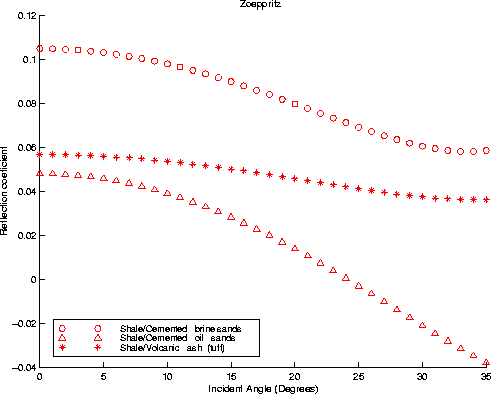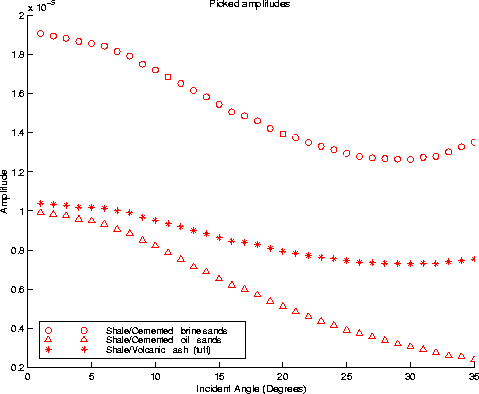| |
(2) |
| (3) |
| (4) |
where
Vp=(Vp2 + Vp1)/2,
Vs= (Vs2 + Vs1)/2,
![]() ,
,
![]() ,
,
![]() ,
,
![]() .
.
The normal incident term, A, is commonly referred to as the AVO intercept
attribute, the intermediate angles term, B, is referred to as the AVO gradient
attribute.
We use this approximation to invert for the intercept and gradient
AVO attributes from the observed reflection amplitude variation
with angle in the angle-domain common image gathers (CIG).
In this domain, we pick the amplitude values at the reflector
of interest and fit the amplitude versus ![]() to a best straight-line
approximation using a least-squares curve fitting method.
to a best straight-line
approximation using a least-squares curve fitting method.
Providing a reference for the expected AVO response for the shale/brine, shale/oil, and shale/tuff interface, Figure 5 shows the P-wave reflection coefficient from the exact Zoeppritz equations.
|
zoeppritz
Figure 5 P-wave reflection coefficient from Zoeppritz equations |  |
At the near offset we expect a similar reflection coefficient (similar intercept attribute) for the shale/oil and the shale/tuff interfaces because of similar acoustic impedance; however this ambiguity can be resolved by the different radio between Vs and Vp (different gradient attribute). Although this calculation is valid only for a 2-layer model, it will be a reference for the expected tendency in the modeled data. Deviation from this tendency should be due to modeling effect, overburden effect, migration operator effect, velocity anomalies effect, and migration-velocity errors. We examined the modeling effect using a 1-D, 2-layer synthetic model, the overburden and migration operator effects using model 1 (overburden with flat interface), and then we use model 2 (overburden with sinusoidal interface) to understand the effect of velocity anomalies and migration-velocity errors.
|
2laypick
Figure 6 Picked amplitudes for a 2-layer modeling case |  |